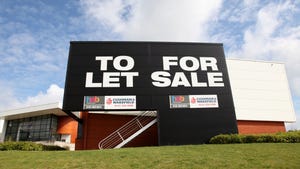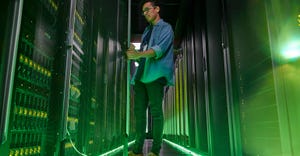Exploring the Future of Data Center Construction With Vertiv
In this video, Vertiv’s Greg Stover discusses the emerging trend of modular prefab construction in data centers.
June 23, 2023

At Data Center World 2023, Steven Hill of Data Center Knowledge connected with Greg Stover, global director of high-tech development at Vertiv. They discussed the trend of modular prefab construction in data centers, as well as other aspects of data center technology and infrastructure.
The transcript follows below. Minor edits have been made for clarity.
Transcript:
Steven Hill: Good morning from Data Center World in 2023. I'm Stephen Hill, and with me today is a representative of Vertiv, which is an American, Ohio-based provider of equipment and services for data centers. Today, Vertiv offers a substantial lineup of technology that spans nearly every facet of the data center environment for power distribution, infrastructure cooling, cable management, racking, device management, and containment. That spans everything from the network closet to the cloud and beyond, and mission-critical applications of any size. And welcome today is Greg Stover, who's a global director of high-tech development at Vertiv. Welcome.
Greg Stover: Steve, good to see you.
Steven: Nice to talk to you, sir. Tell us about what you do.
Greg: All right, so interesting title: Global Director of High-tech Development. The short version of that is I'm meeting with the disruptors that are developing technologies that might affect our infrastructure environments. That's the OEMs and the chip guys, and we've learned to follow all the way back to the chip. We've learned as TDPs are going up and power requirements are changing as a result, cooling requirements are changing as a result. So, how do we get ahead of that curve and make sure we enable the world to accept these new technologies? That's the fun job I have now.
Steven: Right, and this has been going on for a while. I mean, you look at the power of the systems that are showing up. Racks that used to be five kilowatts are now 50 kilowatts and going upwards.
Greg: Yeah, exponential growth.
Steven: And it's not just about powering them, it's about cooling all of that. Because people don't always realize that from a data center perspective, energy in equals heat out – an almost one-to-one ratio.
Greg: All day, every day.
Steven: So, we're talking about some of the new systems. If you say 50 kilowatts, it’s like 50 hairdryers blowing at you all the time. So, we're talking about something interesting today. There's a new trend in data center construction: modularity prefab. The challenge of dealing with construction, most data centers were bespoke construction. But now, we're talking about the ability to be able to build prefabricated modules that are far more standardized and can simplify and speed up the construction process. Tell me about what you're doing in terms of prefabrication.
Greg: So, we've been in a modular prefabricated space for quite a while, and it was a pretty niche kind of solution at the time. But we're finding the applications today, given all this going on in the world – the supply chain, latency issues, and compute having to be closer to the consumers of that product. There's a significant market for rapidly deployable prefabricated factory-tested solutions to go out in the marketplace. And whereas in the beginning, I think we were fairly custom on building what everybody wants, and we still do a lot of customization.
Now, we're at the point because of the scale and the demand for modular solutions, that we're building reference designs and best practices that try to create standardized models that can be customized based on individual customers' needs. And we're seeing it in a couple of different environments where we're having complete, totally turnkey all-in-one data centers. It's a complete infrastructure. It's the housing for the equipment, the cooling for the equipment, and the power for the equipment. It's remote management and security. Everything is in a box. You deploy it onto a slab or into a warehouse. You connect the power, you connect the cooling, and you're off and running.
The other trend that we're seeing is modular and skidded power and cooling solutions for even the large stick-built facilities. There's significant value to being able to have those fabricated and tested, put together by us in our factories, by our people, and made to work together. And when we do that, they can become much, much more efficient. And you have the issue of labor. Labor has been a big issue.
If our customers don't have to go out and hire teams to come to build stick-built facilities – and don't get me wrong, stick-built is not going away. Those are our customers, and we love them. It's not going to be an either/or – it's going to be an and. I mean, we can augment where I need capacity quickly. We can augment where I moved everything to the cloud, but now it's starting to repatriate back, as Bill Kleyman said in his keynote. A lot is coming back for a variety of reasons, and it's not that the cloud won’t continue to grow. Everything's growing, but we're finding out what applications need to be where and what that means to the marketplace.
And it's going to be a hybrid world. You're going to have equipment in the cloud. You're going to have equipment at the colo. You have colos getting into the modular space because they see the value of this whole hub-and-spoke thing. You're going to have people at enterprises that maybe don't have perfect facilities, but they need to bring in equipment that won't fit in any space they have. They can drop this in a parking lot and turn them up and they've got a world-class, mission-critical facility.
Steven: And again, that's the interesting thing because a data center is a complex environment when you start looking at it. When you talk about the power of the cooling and the security that's necessary to keep it running.
Watch Part 2 of Greg Stover’s interview
About the Author
You May Also Like







